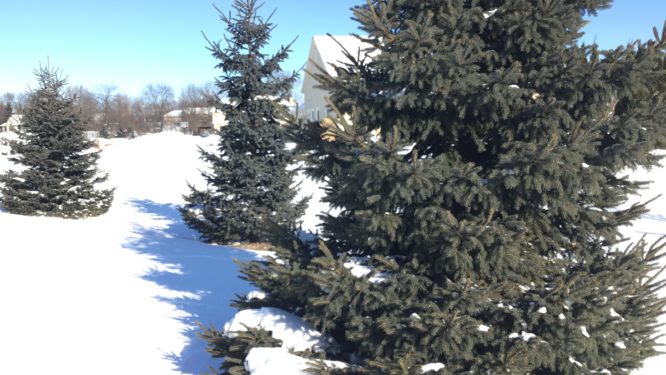At first glance, most evergreen trees can appear almost identical — tall, green, and covered in needles all year round. But did you know that there are over 600 species of evergreens worldwide, each with unique traits that help them survive in different climates? That’s where evergreen identification becomes fascinating. Recognizing the subtle details — from the shape and texture of needles to the structure of cones — can reveal whether you’re looking at a fir, spruce, or pine.
Discover how to tell these three common evergreens apart using a few simple but reliable methods.
How to Identify Evergreen Trees
Evergreen trees are a diverse group, with numerous evergreen species thriving in different climates around the world. While they may appear similar at first glance, learning how to identify evergreen trees can reveal fascinating differences in needles, cones, and overall tree shape.
The process of identifying evergreen trees generally involves a few key observations:
-
Needle or leaf shape – examine whether the needles are long, short, flat, or pointed. Some species, like firs, have soft, flat needles, while spruces have sharp, square needles that roll between your fingers.
-
Needle arrangement – look closely at how the needles attach to branches. Are they clustered, attached singly, or spiraled around the twig?
-
Cone characteristics – observe the size, shape, and texture of the cones. Cones can help distinguish between pines, spruces, and firs.
-
Tree shape and growth habit – consider the overall silhouette. Some evergreens are tall and narrow, while others spread widely or form dense, symmetrical shapes.
By paying attention to these details, anyone can begin to recognize different evergreen species and confidently identify evergreen trees in their local forests or gardens. Also, it helps you to choose the correct tree service.

The Most Effective Method to Identify a Fir Tree
Fir trees are broadly viewed as the most widely chosen evergreen to use as a Christmas tree. However, that is not all they're known for! Fir trees are also appreciated for their pleasant fragrance and symmetrical, elegant shape, which make them popular in landscaping. Additionally, their needles are soft to the touch, making them safer and more comfortable for homes with children or pets. For anyone interested in evergreen tree identification, observing the distinctive qualities of a Fir tree’s needles and cones is a great place to start. See the most prominent qualities of the needles and cones of a Fir tree beneath.
Fir Tree Identification by Needles
Fir needles develop separately along the tree's branches, a key distinction that helps you identify evergreen tree species. This contrasts sharply with Pine needles, which grow in clusters or bunches, making them easy to tell apart.
Additionally, Fir trees have several unique needle characteristics that set them apart from other evergreen trees types:
-
Shape: fir needles are flattened, almost as if pressed, and their tips are rounded rather than sharp. This gives the branches a soft, elegant appearance that is often preferred for indoor Christmas trees.
-
Surface: fir needles are delicate and relatively easy to twist between your fingers, unlike the stiff, prickly needles of Spruce trees.
-
Color and texture: many Fir species feature a deep, rich green or bluish-green color, adding to their ornamental appeal. The needles also tend to remain fresh longer after being cut, which is why Firs are a favorite for holiday decorations.
Examining these details — how needles attach, their shape, and texture — allows you to confidently identify evergreen tree species and distinguish among the many evergreen trees types found in forests, gardens, or nurseries. Paying close attention to these needle characteristics is a reliable method for evergreen tree identification by needles. With practice, even subtle differences in needle length, flexibility, and color can reveal the species at a glance, making tree identification both easy and enjoyable.
Fir Tree Cones Identification
What genuinely sets Fir trees apart from other evergreens are their cones. They develop upward, which is not the same as Pine and Spruce cones, which hang towards the ground. Furthermore, Fir tree cones can take on an assortment of shadings, from green to blue or purple, before turning to a more earthy-colored tone.
Equally important for identification are the evergreen tree needles, which provide key visual and tactile clues. Fir evergreen tree needles are soft, flat, and rounded at the tips, contrasting sharply with the sharp, stiff needles of Spruce or clustered Pine needles. Observing both the cones and the evergreen tree needles together makes it easier to distinguish Firs from other evergreen trees types. Paying attention to the texture, color, and attachment of the evergreen tree needles ensures accurate identification even from a distance.
Common Types of Fir Trees
Fir trees are popular not only for their beauty but also for their versatility, and knowing the different evergreen tree types can help you identify fir trees more easily. Here are some of the most common species:
-
-
Noble fir: known for its sturdy branches and bluish-green needles, the Noble Fir is often used for large Christmas trees and landscaping. Its strong limbs make it ideal for holding heavy ornaments.
-
Balsam fir: recognizable by its fragrant, dark green needles and symmetrical shape, the Balsam Fir is a favorite for holiday decorations and is commonly found in North American forests.
-
Grand fir: this species features long, flat needles with a glossy green appearance and a pleasant citrus-like scent. Grand Firs are often planted as ornamental trees in parks and gardens.
-
Fraser fir: fraser Firs have soft, short needles and a compact, pyramidal shape, making them excellent for indoor Christmas trees. They are also resistant to many pests and diseases, which makes them low-maintenance.
-
Douglas fir: though not a true fir, the Douglas Fir is closely related and distinguished by its long, soft needles and large, hanging cones. It is widely used for timber and ornamental purposes.
-
Knowing the differences among evergreen tree types makes it easier to identify fir trees in the wild, in gardens, or at tree farms. Paying attention to needle shape, branch structure, and cone characteristics is essential for distinguishing one Fir species from another.
The Most Effective Method to Identify A Spruce Tree
There are roughly 40 types of Spruce trees around the world, each with the needle and cone properties described below. Spruce trees are easily distinguished by their stiff, sharp, and four-sided needles, which grow individually along the branches. Their cones are typically cylindrical and hang downward, providing a clear contrast to the upright cones of Fir trees. Paying attention to these characteristics is essential for anyone focused on identification evergreen tree species, as needle texture, arrangement, and cone orientation are key features for accurate classification.
Spruce Tree Identification by Needles
Like Fir trees, Spruce tree needles develop separately along the branches. However, unlike Firs, Spruce trees feature a small notch at the base of each needle called the sterigmata, which is where the needle attaches to the branch. Recognizing this unique feature is a key step in identifying evergreens.
Here are additional characteristics of Spruce needles that help how to identify spruce trees:
-
Shape: spruce needles are almost square in cross-section, with clearly defined edges that you can feel when rolling a needle between your fingers. Their tips are sharp and pointed, making them noticeably pricklier than Fir needles.
-
Surface: spruce needles are firm and smooth, with a slightly glossy appearance. Their stiffness and distinct texture make them easy to differentiate from the soft, flexible needles of Firs.
-
Arrangement and color: spruce needles grow individually in a spiral pattern around the branch and often have a bluish-green or dark green color, adding another clue for identifying evergreens.
Observing these details — the needle shape, texture, attachment, and color — is essential when learning how to identify spruce trees in the forest, garden, or nursery.
Spruce Tree Cones Identification
Spruce tree cones hang downward, in contrast to the upright cones of Fir trees, and they have small scales that make them smoother to the touch than Pine cones. They are also quite flexible — you can gently twist a Spruce cone, a feature not possible with the rigid Pine cones. These cone characteristics, along with needle shape and texture, are important clues when learning to distinguish among different types of evergreen trees.
Common Types of Spruce Trees
-
Colorado spruce: known for its striking bluish-green needles and symmetrical shape, the Colorado Spruce is popular in landscaping and as a decorative tree during the holidays.
-
Norway spruce: this species is widely planted for timber and ornamental purposes. Its long, hanging branches and dark green needles make it easily recognizable.
-
Black spruce: smaller and more compact, the Black Spruce has short, stiff needles and tiny cones, often thriving in colder northern climates.
-
Alberta spruce: often used as a hedge or accent tree, the Alberta Spruce features dense, narrow growth and soft green needles.
-
White spruce: with its light green needles and medium-sized cones, the White Spruce is common in North American forests and is valued for timber and ornamental use.
Recognizing these characteristics — needle texture, cone shape, and overall tree form — makes it easier to identify Spruce trees and understand their place among different types of evergreen trees.

The Most Effective Method to Identify A Pine Tree
Pine trees are notable for their fragrant, beautiful cones. The following are more differences that separate these trees from other evergreens. Pine needles typically grow in clusters called fascicles, unlike the single needles of Firs and Spruces. They are long, slender, and often flexible, giving the tree a distinctive feathery appearance. Pine cones are generally larger and harder than Spruce or Fir cones, and they often have a woody, textured surface. Additionally, many Pine species produce seeds that are a favorite food for wildlife, making them an important part of forest ecosystems.
Pine Tree Identification by Needles
Pine trees differ significantly from their Spruce and Fir relatives, which makes understanding evergreen vs pine tree identification easier. Unlike Fir and Spruce needles that grow individually along the branches, Pine needles grow in clusters called fascicles, typically containing 2 to 5 needles per bundle. Recognizing this clustering is a key factor when learning pine tree vs evergreen distinctions.
Here’s additional identifying information on Pine needles:
-
Shape: pine needles are long, slender, and somewhat flattened on one side. Their length and flexibility give Pine trees a distinctive feathery look, setting them apart from other evergreen tree types.
-
Surface: pine needles are smooth to the touch and relatively flexible, though they can be brittle compared to Fir needles. Their unique texture and arrangement are helpful features when trying to identify evergreen trees.
-
Color and arrangement: pine needles often display a bright or deep green hue and grow in well-defined clusters, making them easier to spot from a distance compared to the single needles of Spruce or Fir.
By observing the needle clusters, texture, and arrangement, you can confidently differentiate Pine trees from other evergreens, mastering evergreen vs pine tree and pine tree vs evergreen identification.
Pine Tree Cones Identification
Pine cone scales are hard and rough to the touch, making them distinct from the smoother, more flexible cones of Spruce trees. Unlike Spruce cones, Pine cones cannot be twisted easily, which is a useful feature when learning how can you tell the difference between evergreen trees? Observing the texture, size, and orientation of cones, along with needle arrangement, provides clear clues for identification. Pine trees also have long needle clusters and often a more open branching structure, further helping to distinguish them from Fir and Spruce trees.
Common Types of Pine Trees
-
Eastern white pine: known for its long, soft needles and tall, straight growth, this species is popular for timber and ornamental use.
-
Bristlecone pine: famous for its extreme longevity, the Bristlecone Pine has short needles and uniquely twisted branches.
-
Sugar pine: the largest of all Pine species, it features extremely long cones and long needle clusters, making it easily recognizable.
-
Scots pine: with orange-brown bark and medium-length needles in pairs, the Scots Pine is widely planted in Europe and North America.
-
Loblolly pine: common in the southeastern United States, it has long, dark green needles in threes and produces sizable, woody cones.
Learning to examine needles, cones, and growth habits carefully answers the question how can you tell the difference between evergreen trees? and helps accurately identify the various evergreen tree types in forests, gardens, or tree farms.
To sum up, while many evergreen trees may look similar at first glance, understanding their unique characteristics makes evergreen trees identification both practical and rewarding. By paying attention to needle shape, arrangement, texture, and cone structure, you can confidently distinguish among the most common types of evergreens: Fir, Spruce, and Pine. Each species has its own defining traits, from the soft, flat needles of Firs to the sharp, square needles of Spruces and the clustered, long needles of Pines. With these simple yet reliable methods, identifying evergreen trees in forests, gardens, or even your backyard becomes an enjoyable and educational experience.
While they appear similar from afar, evergreen trees can be quite different from one another in many ways. No matter which kind you choose, the team at Tree Doctors is here to help you care for them, ensuring your landscape stays healthy and beautiful.
FAQ
What are the common types of evergreen trees in Canada?
Canada is home to a variety of types of evergreen trees in Canada, including Fir, Spruce, Pine, and Hemlock. Each species has unique needle shapes, cone structures, and growth habits that help distinguish them from one another.
How can I identify a Fir tree?
Knowing how to identify a fir tree starts with examining its needles and cones. Fir needles are flat, soft, and rounded at the tips, and they grow individually along the branches. Fir cones stand upright on the branches, unlike Spruce and Pine cones that hang downward. Learning these traits is key to fir trees identification.
What are evergreen needles, and why are they important?
Evergreen needles are the leaves of evergreen trees that stay green year-round. Their shape, texture, and arrangement are critical for distinguishing one species from another. For example, Spruce needles are stiff and square-shaped, while Pine needles grow in clusters.
How do I identify an evergreen tree?
To identify an evergreen tree, observe the needle arrangement, shape, texture, and cone type. Notice whether the needles grow singly or in clusters, their softness or stiffness, and the orientation of the cones. These details make it easier to determine whether you are looking at a Fir, Spruce, or Pine.
What are some examples of long needle evergreen trees?
Long needle evergreen trees include species like Eastern White Pine and Sugar Pine. These trees feature long, slender needles that grow in clusters, which are very different from the short, individual needles of Spruce or the flat needles of Fir.
How can I tell evergreen trees apart?
You can tell evergreen trees apart by comparing their needles, cones, and overall growth habit. Firs have soft, flat needles and upright cones; Spruces have stiff, square needles and hanging cones; and Pines have long needle clusters and large, woody cones. Paying attention to these details allows you to differentiate between species confidently and choose the right tree care.
What kind of evergreen tree do I have?
To figure out what kind of evergreen tree do I have, examine the needles and cones closely. Are the needles in clusters or single? Are the cones upright or hanging? Observing these characteristics will help you determine whether your tree is a Fir, Spruce, Pine, or another type of evergreen.











